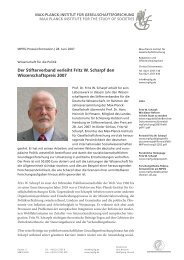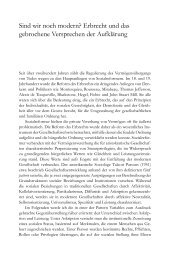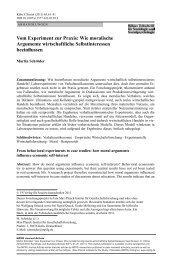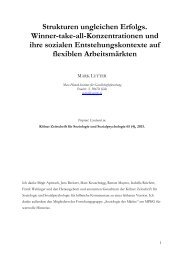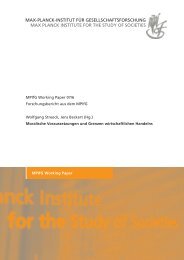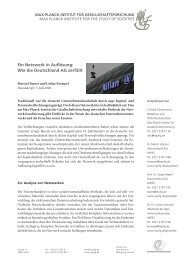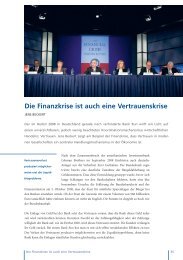You also want an ePaper? Increase the reach of your titles
YUMPU automatically turns print PDFs into web optimized ePapers that Google loves.
Streeck, Mertens: <strong>An</strong> <strong>Index</strong> <strong>of</strong> <strong>Fiscal</strong> <strong>Democracy</strong> 5<br />
The idea is not new that “policy legacies” may accumulate over time, constraining the<br />
choices <strong>of</strong> elected governments and parliaments and diminishing the capacity <strong>of</strong> states<br />
to respond to emerging social problems (Pierson 1998, 2001; Rose 1990; Rose/Davies<br />
1994; Rose/Karran 1987). Not only is it hard to abolish spending programs even after<br />
they have outlived their original purpose, but <strong>of</strong>ten programs have builtin mechanisms<br />
that incrementally increase the cost – following the logic <strong>of</strong> compound interest – far<br />
beyond what was expected at the time <strong>of</strong> their inception. This holds in particular for<br />
socalled payasyougo social security programs that become more costly as they “mature”<br />
in time, i.e., as the number <strong>of</strong> claimants entitled to benefits increases, and average<br />
benefits increase with the number <strong>of</strong> years <strong>of</strong> enrollment (Pierson 2001).<br />
Since the late 1970s, the problem <strong>of</strong> accumulating policy legacies has been a prominent<br />
theme in the literature on public finance. In addition to the high survival rate <strong>of</strong> political<br />
programs and the quasiautomatic increase in social security and other entitlement<br />
spending, the chronic budget deficits <strong>of</strong> most democratic states and the resulting rise<br />
in public debt have significantly limited the degrees <strong>of</strong> freedom left to governments<br />
in the deployment <strong>of</strong> scarce fiscal means. Democratic states in particular seem to be<br />
under strong pressure to manage distributional conflict in their societies and political<br />
economies by augmenting available resources through borrowing from the future. As<br />
a result, public debt increases, as does the yearly interest on the public debt. Like the<br />
mounting costs <strong>of</strong> inherited programs and maturing entitlements, debt service is thus<br />
likely to consume a rising share <strong>of</strong> tax revenue, and thereby gradually fill the fiscal space<br />
for policy innovation and increasingly preempt democratic choice. 1<br />
Accumulation <strong>of</strong> policy legacies may be conceived as a process <strong>of</strong> institutional sclerosis<br />
(Olson 1982) or institutional aging (Streeck 2009). The concepts introduce time as a<br />
causal factor in the analysis <strong>of</strong> institutional change, raising the possibility, for example,<br />
that the longer a democratic political system has existed, the less flexible it will be with<br />
respect to the allocation <strong>of</strong> its available resources. From this perspective, a wide variety<br />
<strong>of</strong> themes comes into view. Among other things, it may be hypothesized that tax increases,<br />
which would temporarily suspend institutional aging, will be the more difficult<br />
to achieve in a democracy the further the aging process has already progressed. The<br />
reason is that a tax increase that is used in full or in part to service or pay <strong>of</strong>f the public<br />
debt does not directly benefit those who must agree to it. Sclerotic foreclosure <strong>of</strong> policy<br />
innovation over time may in this way become selfreinforcing and eventually undermine<br />
the viability <strong>of</strong> democratic politics as such. 2<br />
1 For a concise formulation <strong>of</strong> the problem, see Stiglitz’s account <strong>of</strong> the policies <strong>of</strong> the first Clinton<br />
administration which took <strong>of</strong>fice in 1993: “That the deficits were not sustainable in the long<br />
run was clear … With a growing debt, the federal government had to pay higher and higher<br />
interest rates, and with higher interest rates and more debt, more and more money simply went<br />
to pay interest on the national debt. These interest payments would eventually crowd out other<br />
forms <strong>of</strong> expenditure …” (Stiglitz 2003: 35–36)<br />
2 On selfundermining institutions, see Greif (2006) and Greif and Latin (2004).







